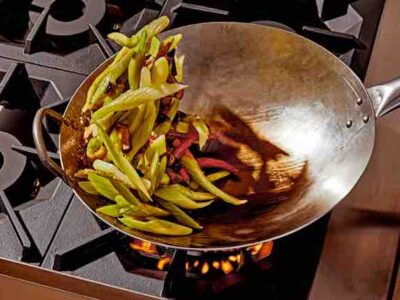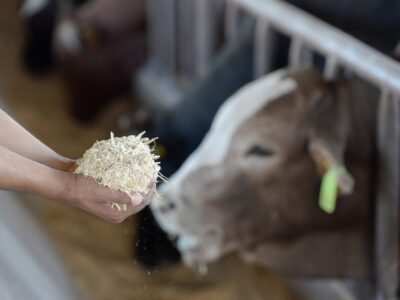For the past decade, Rescuing Leftover Cuisine (RLC) has filled a significant and ever-growing role in the battle against food waste in America. The nonprofit was founded in 2013 by Robert Lee and Louisa Chen, who met while student volunteers for a New York University group that brought dining hall food leftovers to homeless shelters.
The organization started in New York City, delivering food donations that weren’t large enough for typical food rescue groups to handle. For RLC’s co-founder and current CEO, Lee, battling food insecurity has been an important and highly personal issue since he experienced it while growing up as the son of South Korean immigrants.
The sheer numbers behind the intertwined problems of food waste and food insecurity are quite startling. Recycle Track Systems says that around 60 million tons of food is wasted in the United States, and according to a U.S. Department of Agriculture (USDA) report, nearly 13% of American households experienced food insecurity during 2022 — a jump from 10.2% in 2021.
Andrew Creamer, RLC’s marketing director, told Garden & Health that “if we diverted just 15% of the food we waste, we would bring down the number of food insecure Americans by 50%.”
Photo Courtesy Rescuing Leftover Cuisine
RLC, which has provided meals to more than 3.5 million people, follows a relatively straightforward food recovery formula. It sends out a volunteer or paid “rescuers” to various businesses — restaurants, bakeries, food retailers, and even companies who have catered meals — and then they bring the food to organizations, such as food banks, soup kitchens, and homeless shelters, that help those with food insecurities.
RLC utilizes a specially designed app that allows the rescuers to operate efficiently. Its website says that its 10-cent-per-pound efficiency average easily beats the 24-cent-per-pound average of typical food rescue organizations.
RLC’s success has led to its spreading to more communities across the U.S. The nonprofit’s other branches are in the cities of Atlanta, Chicago, Columbus, Ohio, and Dallas and the states of Massachusetts, New Jersey, and Rhode Island. 2023 saw it establish its first West Coast outpost in Los Angeles.
While still following its no-minimum size donation policy — although, due to regulations, it can’t accept homemade food — the organization also has recently made a concerted effort to expand its operating model by seeking donors higher up the supply chain.
By working with companies like Kind Snacks, Daily Harvest, Frito Lay, and TruRoots, RLC is able to rescue thousands of pounds of food at one time. Plus, these donations can be made at locations beyond where branches are located. Creamer stated that these large-scale food rescues constitute the bulk of their donations.
Photo Courtesy Rescuing Leftover Cuisine
Over the past few years, RLC has seen a big jump in its rescued food numbers. In 2022, the organization collected more than 2,941,000 pounds of food, which jumped to nearly 3,800,000 pounds (its largest ever) in 2023 — its goal for 2024 is 4,500,000 pounds. The increase is partially due to their expansion and the public’s increased knowledge of food waste.
However, another factor was the passage of the Food Donation Improvement Act in 2022, which has made it easier for businesses to donate food by increasing liability protections.
“One of the biggest challenges now is awareness and education around the issue of food donation and ensuring all potential food donors are aware of the protections,” Creamer explained.
The pandemic, obviously, contributed to a rise in food insecurity and more awareness about it. However, Creamer also pointed out that the record-high inflation levels in 2022 and 2023 served to boost the levels of food insecurity in America, as reflected in the USDA’s report that revealed an increase from 33.8 million in 2021 to 44.2 million in 2022 along with a 45% growth in food insecurity among children.
Creamer shared a story about a family of migrants with four children who had gone days without food before arriving at the doors of the ReVive Center in Chicago, and they were able to have their first meal in the city there due to RLC-provided food donations. He also mentioned how eye-opening it was for him to see high-quality food that is rescued.
“When you think of excess food, you might think of scraps, but a lot of the food is healthy and delicious and something people pay a premium for,” Creamer said.
Photo Courtesy Rescuing Leftover Cuisine
Besides giving those in need good food, RLC also delivers environmental benefits. A 2021 U.S. Environmental Protection Agency report stated that food waste and loss in America alone creates around 170 million metric tons of greenhouse gas emissions. That’s the same as carbon dioxide emissions created yearly by 42 coal-fired power plants. And that figure doesn’t even include emissions generated from food dumped in landfills!
The raised awareness of climate change, however, has resulted in some new laws aimed at preventing food waste from winding up in landfills. Hopefully, such legislation will increase RLC’s productivity, allowing more people to have greater food security.





